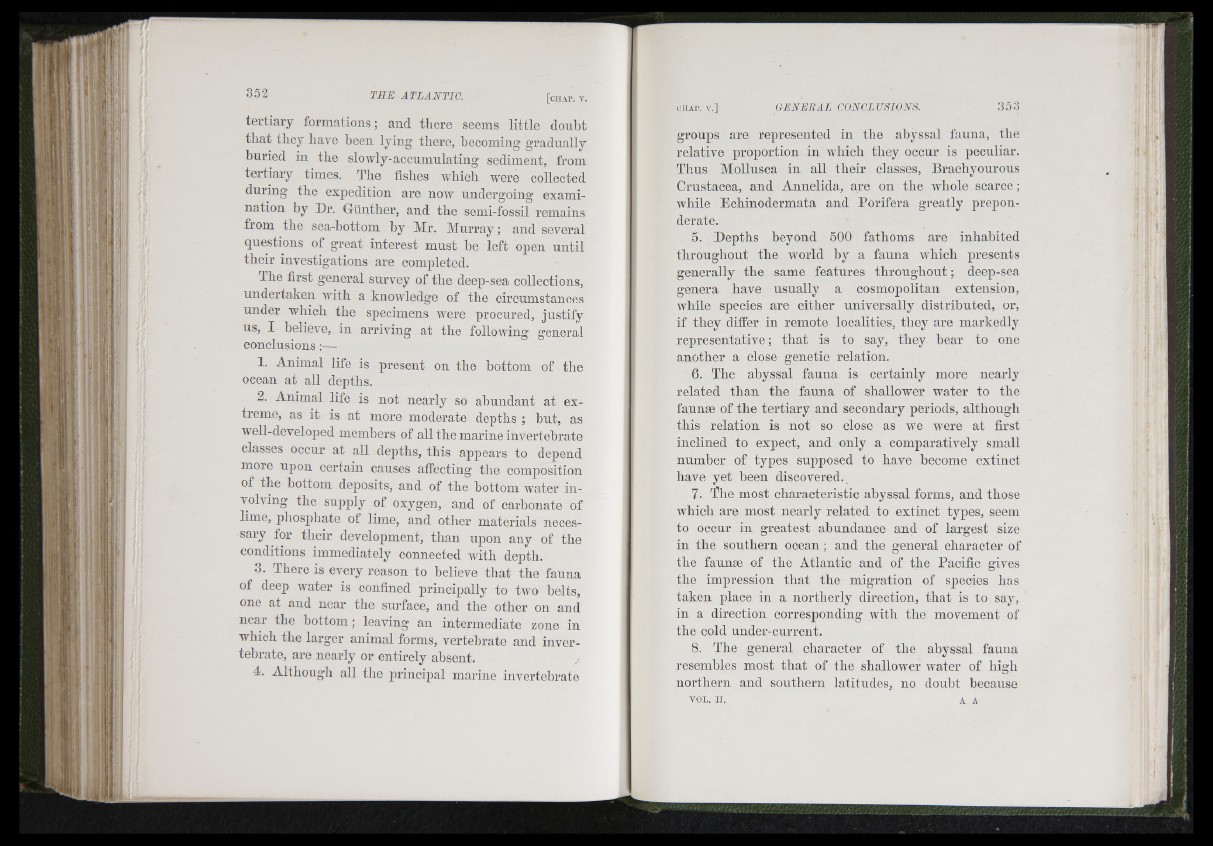
i ' ■ H 4
: G ' P ä l l l
. -i" ;■ Vm'i
' toI' r. i; 1. \»i 'b:
-u|
A ' t
U . f
A ! I!
ISi "
ir
i i rd ji
4;
.ji
'• »(41•: ![ S'
w
: ■
rf ^ i
Mfto
.==, i-: '
'i'ïi ;
ili:: ;
iiii j
■iU !
: S’to -
:■(, i
■if :■
Iiii
', , ;L»'.rÉ'; : XI c :
i\V
■ (H.
i - l
iii
352 THE ATLANTIC. [ciIAP. V.
tertiary formations; and there seems little doubt
that they have been lying tbere, becoming gradually
buried in tbe slowly-accumulating sediment, from
tertiary times. Tbe fisbes Avhicb Avere collected
during tbe expedition are uoav undergoing examination
by Dr. Güntber, and tbe semi-fossil remains
from tbe sea-bottom by Mr. Murray; and several
questions of great interest must be left open until
tbeir investigations are completed.
Tbe first general survey of tbe deep-sea collections,
undertaken Avdtli a knowledge of tbe circumstances
under wbicli tbe specimens Avere procured, justify
us, I believe, in arrlA'ing at tbe following general
conclusions:—
1. Animal life is present on tbe bottom of the
ocean at all depths.
2. Animal life is not nearly so abundant at extreme,
as it is at more moderate depths ; but, as
Avell-developed members of all the marine invertebrate
classes occur at all depths, this appears to depend
more upon certain causes affecting the composition
of the hottom deposits, and of the bottom water involving
the supply of oxygen, and of carbonate of
lime, phosphate of lime, and other materials necessary
for their development, than upon any of the
conditions immediately connected with depth.
3. There is every reason to believe th a t the fauna
of deep Avater is confined principally to tAvo belts,
one at and near the surface, and the other on and
near the hottom; leaving an intermediate zone in
which the larger animal forms, vertebrate and invertebrate,
are nearly or entirely absent. /
4. Although all t]ie principal marine invertebrate
uriAr. \’.] CE N E E A L CONCL USIONS. 353
groups are represented in tbe abyssal fauna, tbe
relative proportion in Avbich tbey occur is peculiar.
Tbus Mollusca in all tbeir classes, Bracbyourous
Crustacea, and Annelida, are on tbe AA'bole scarce ;
while Ecbinodermata and Porifera greatly preponderate.
5. Depths beyond 500 fathoms are inhabited
throughout the Avorld by a fauna which presents
generally the same features throughout ; deep-sea
genera have usually a cosmopolitan extension,
while species are either universally distributed, or,
if they differ in remote localities, they are markedly
representative ; th a t is to say, they hear to one
another a close genetic relation.
6. The abyssal fauna is certainly more nearly
related than the fauna of shallower water to the
faunæ of the tertiary and secondary periods, although
this relation is not so close as we were at first
inclined to expect, and only a comparatively small
number of types supposed to have become extinct
have yet been discovered.
7. The most characteristic abyssal forms, and those
which are most nearly related to extinct types, seem
to occur in greatest abundance and of largest size
in tbe sontbern ocean ; aud tbe general character of
tbe faunæ of tbe Atlantic and of tbe Pacific gives
the impression tb a t the migration of species has
taken place in a northerly direction, th a t is to say,
in a direction corresponding with the movement of
the cold under-current.
8. The general character of the abyssal fauna
resembles most th a t of the shalloAver Avater of high
northern and southern latitudes, no doubt because
VOL. II. A A
G
II